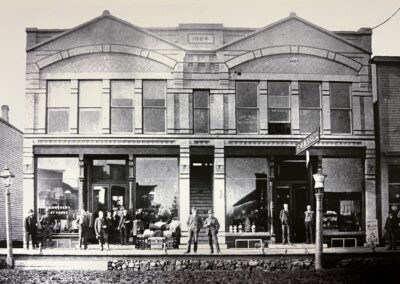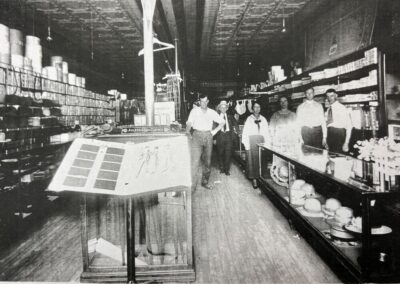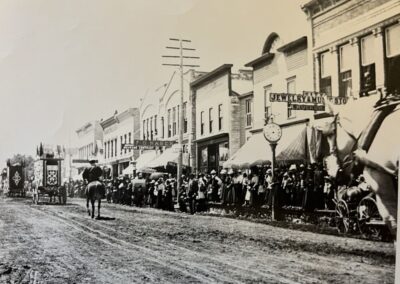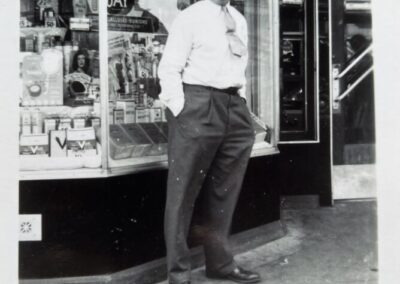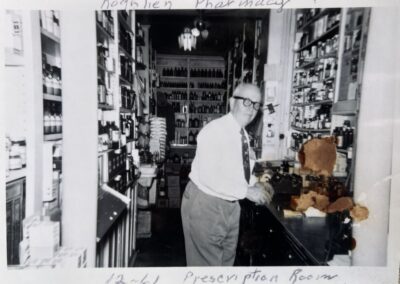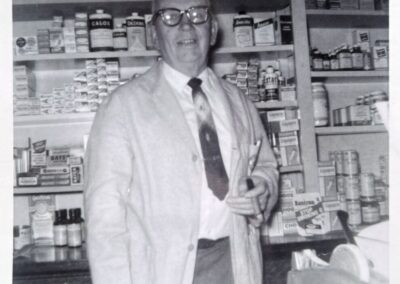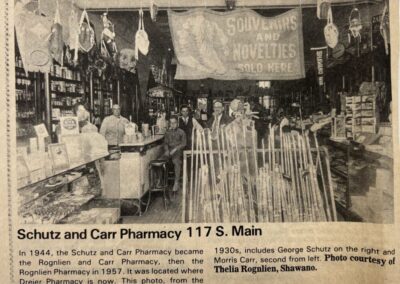Location
Photo Gallery
Built in 1884, the Andrews & Klosterman Dry Goods Store occupied the building on the left, with the Naber Drug Store on the right.
An early photo of Main Street in Shawano, looking to the south. You’ll see the Andrews & Klosterman Store on the right. Notice, the two buildings to the south of Andrews & Klosterman sill exist today.
A Brief History
The Andrews & Klosterman Dry Goods and Naber Stores
115 & 121 S. Main St.
Shawano, Wisconsin
Built in 1884, the Andrews and Klosterman Dry Goods Store and Naber Drug store on Shawano’s Main Street has been the Dreier Pharmacy and Gift Shoppe since 1967.
The address of Dreiers in 2023 is 117 S. Main Street but in the late 1800’s, the addresses of Andrews and Klosterman was 121 S. Main and the Naber Drug Store was 115 S. Main Street. Addresses change.
The Naber Drug store was built on the original site of the old Naber store and was the former home of Mrs. Mary Naber Zachow. In the first photo, note the hitching posts on the sidewalk and the and goods and trunks in front of the Andrews & Klosterman store and the pottery in Naber Drug Store window. You can also see store clerks looking out the window in the Klosterman side of the store. Left in the doorway of the first photo is Jessie Brooks, H. H. Andrews and Anton Kuckuk, (grandfather of Jack Kuckuk). On the front of steps on left is Captain John Schweers (father of Frank Schweers) and in the doorway of Naber Drug, Charles Naber and Frank Naber. In the second story were the offices of Dr. McComb, early physician.
After Naber, the business became the Schutz and Carr pharmacy and in 1944, the Rognlien and Carr pharmacy. Then in 1957 Rognlien took ownership.
H. Klosterman
H. Klosterman, one of the representative prosperous citizens of Shawano county, agriculturist, dealer in real estate, and capitalist, is a native of the Grand Duchy of Oldenburg, Germany, born April 20, 1832. He is the eldest in the family of three sons and three daughters born to Gerhard H. Klosterman, a tailor by trade in Oldenburg, where he passed all his days. Our subject received a somewhat limited common-school training in his native land, and was offered free education for the ministry, but declined. But what he may not have learned at school, where he was a quick and apt scholar, he made up for by home study and a close observation of men and things, and he also commenced earning money at a very early age, for at about the age of ten we find him herding cattle and sheep, receiving, it is true, very small wages. In his youth he displayed a penchant for carpentry, and, learning the trade, followed it till 1855, in which year, in company with his uncle, Edwin Wilke (his mother’s brother), who kindly furnished him with the means, he came to the United States, the voyage being made on the sailing vessel “Nelson” from Bremen for New York, the voyage occupying seven weeks, three days. From the latter city the journey was made by rail to Buffalo, thence by lake to Sheboygan, Wis., where our subject secured work among the farmers, the first money he earned in the United States being at chopping cordwood, an “art” he was taught by a woman. Here he remained until early in the spring of 1857, when he moved to near Two Rivers, where his uncle lived, for whom he now worked, in order to repay him the price of his passage from Germany. Subsequently he worked for other farmers, and later in a sawmill and gristmill at or in the vicinity of Two Rivers, for three years, at the end of which time he went to Racine, Wis., and on the prairie near that city worked as a farm hand, in the fall of the same year going into the lumber woods.
In his somewhat varied experience Mr. Klosterman traveled considerably over the State of Wisconsin, and at one time while at Mayville, Dodge county, he bargained with Charles Rudebusch to drive some cattle from there to Shawano, at which latter place, then a mere hamlet of a few shanties, he in the fall of 1860 found work in the lumber woods. In the following spring he married, an event that will be spoken of further on, and he and his young wife commenced keeping house in a log building that stood near the present outskirts of the city; and even this humble home he did not own, for he bought on credit. He also bought a team of oxen and a couple of cows, and with these oxen he went jobbing; but an unfortunate accident happened to him which gave to his now rising prospects a cruel set-back. One day, in the spring of 1861, while he was engaged at plowing his lot with this same yoke of oxen, making ready to put in his crops, the tree-stumps obtruding themselves pretty thickly around, the plow accidentally caught on one of them, which caused the team to give a sudden jerk, whereby the plow handle struck Mr. Klosterman a violent blow close by the knee of the left leg. This produced a fever sore, later a stiff limb with a running sore which left him helpless for a whole year. He had just been married, and his small pile of savings was soon reduced to a minimum, rendering his condition, physically and financially, anything but encouraging. He was helpless as far as manual labor was concerned, and it became clear that his attention must be given to something else totally different to what he had been accustomed to; so he undertook whatever kind of work his enfeebled condition would permit him to do. In consequence of his already injured limb having in December, 1889, received a further hurt by being severely cut with an axe while he was chopping wood at his home, he suffered so severely that the leg had to be amputated September 6, 1890.
For a time Mr. Klosterman kept a small saloon and grocery in Shawano, after which he served as justice of the peace of the village three years, then as register of deeds four years, deputy clerk two years, and he was county judge of Shawano county sixteen years, the longest term held by any incumbent in that office. In February, 1894, he became a member of the firm of Andrews & Klosterman, who conduct a general store in Shawano.
On April 20, 1861, Mr. Klosterman was married in Shawano to Miss Ernstein Fink, a native of Mecklenburg-Schwerin, Germany, born December 21, 1843, and to this union have been born children as follows: Louise, born January 18, 1862, died September 17, 1862, and George H., born June 26, 1869, living at home with his parents. In his political preferences our subject has been a Republican ever since Lincoln’s first term, though his first vote was cast at Two Rivers for James Buchanan. In addition to his other interests which keep him busy he is vice-president of the Shawano County Bank, and deals extensively in real estate, owning at the present time between 600 and 800 acres, chiefly timber land. He is in all respects a public-spirited citizen, of that stamen which is recognized as the bone and sinew of any new country and community. [Source: “Commemorative Biographical Record of the Upper Wisconsin counties of Waupaca, Portage, Wood, Marathon, Lincoln, Oneida, Vilas, Langlade and Shawno” 1895, transcribed by Mary Saggio]

